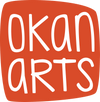By guest blogger Sylvia Pippen—quilt & textile artist, author and teacher.
LA CONNER, WA I discovered cyanotype while living in Hawaii and have been enchanted with the process ever since. The classic cyanotype process—UV-sensitive contact printing—uses transparent, translucent, or opaque objects to make ”blueprint“ photos on paper or cloth.
I loved how I could design my own fabric in hues of blue that blended and complemented sashiko—a centuries-old traditional Japanese running stitch.

Today I incorporate cyanotype printing in my quilt and textile projects. I prefer pre-prepped fabric from Linda Stemer of blueprintsonfabric.com on Vashon Island WA. Linda carries a range of fabrics available in different colors, in addition to cyan blue.
I use her Kona cotton by Robert Kaufman as it’s a high quality, sturdy fabric that’s good for appliqué as well as sashiko. Linda pretreats the fabric with ferric ammonium citrate and potassium ferricyanide, making it ready to print and nontoxic to handle.
The fabric, used dry, comes stored in a black bag to keep out the light. Fresh out of the bag, the cotton is chartreuse. Very mysteriously it transforms into grey when exposed to the sun and then rinses out to vivid blue.

I place the fabric on a sheet of glass, plywood, or a foam core board and then arrange whatever elements I want to use in my design. I comb the woods and my garden for finely cut leaves such as ferns, cedar, Japanese maples, or grasses. Intricate shapes generally are more interesting but there are no hard or fast rules since serendipity plays in this process.
Cut-out silhouettes such as moons or birds can be added. You can also draw designs on overhead projector transparency sheets and place them over your cloth.
A happy accident: I used permanent markers on a transparency in an attempt to make foamy waves. The marker didn’t stick well to the transparency so my line work had different levels of opaqueness. Viola, my print had a variety of blue values. My waves looked like waves!


You can also utilize negatives for photorealistic prints. I use the negative image setting on my printer and print color photos onto a transparency sheet. I am very new to this process and am no authority. I’ve found that high contrast color photos work best and making the photo black and white before changing it to a negative also helps.
With photo negatives, I use windowpane glass on top of the negative and cloth to create maximum contact and get a clear print. With leaves, I don’t use glass as I want some light to filter around the edges of the leaves for more graduations of color.
Now the fun begins. The prepared cloth can now be shifted outside into the sun or placed under a UV sunlamp. If you want consistent results, a UV sunlamp on a timer is the way to go.
I bought a ten-bulb tanning canopy off of Craigslist that works like a charm. I started out using Jimi Hendrix black light bulbs (remember those?) but they are really slow and inefficient.

Anyway, it is much more interesting to work outside with the sun, guessing at exposure times, watching the fabric change colors and getting some Vitamin D in the process.
Exposure times range from 3 to 20 minutes, depending on the intensity and angle of the sun. When you think that you are close to being done, bring your frame and cloth into a shaded area to check on the details of shadows and highlights.
The time of year, time of day, humidity level outside, and overall atmospheric conditions affect your exposure. I find overcast humid days are often best for printing as the longer exposure time gives a more interesting print.

After exposure, wash your developed cyanotype print in running water until the highlights have cleared to white. To deepen the blue color, I dip the fabric in a weak solution of hydrogen peroxide before it’s fully rinsed. The washing is complete when there is no yellow-green coloration in the water. (Shorter washing times may leave ferric salts in the cloth.)
Wring out excess water and hang your print out of direct sunlight to dry or pop it into a dryer. Do not wash your print with phosphate soap or bleach as either will discolor the cloth.
Once the print is dry, it can be ironed and then used in quilts, for pillows or clothing, or stretched on a frame to hang on the wall. Sashiko can be added as another design element to outline foliage or to indicate waves, mountains, etc.
I really like the effect of adding colorful appliquéd birds, flowers or fish on top of the monochromatic cyanotype cloth.

While still living in Hawaii, I printed 1500 panels for my Making Waves block-of-the-month quilt, each panel individually arranged and printed under the intense Hawaiian sun. It was a challenge gauging the right exposure time and second-guessing the next round of “liquid sunshine” (rain).
I’m continually experimenting and have only scratched the surface with this intriguing art form. On the drawing board is another block-of-the-month cyanotype quilt combining sashiko and appliquéd birds and flowers.
To visit Sylvia’s website +click here
EDITOR’S NOTE Sylvia is the daughter of Kitty Pippen, the beloved award-winning quilter who took Houston by storm in 1994 with her majestic quilt, Flight, made with traditional Japanese fabrics. So it’s no wonder that Sylvia, also a Japanophile, plays with blue and white in her textile work.
Since Sylvia moved to La Conner WA, she’s been teaching cyanotype and sashiko workshops in her studio/home. Known as a thoughtful and generous teacher, Sylvia has taught across the country—including at Asilomar and Madeline Island School of the Arts.






